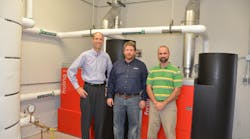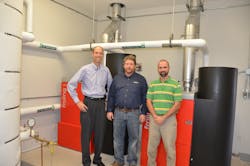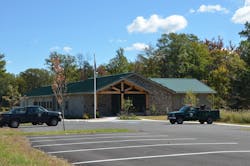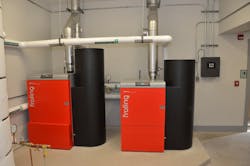PINE GROVE, PA. — Over the past several decades, the term “automatic heating system” was lost in the cold, ash heap of time. Once in the vernacular of heating professionals, the term was conceived when oil took America’s heating systems by storm after M.A. Fessler invented the oil burner to take advantage of the crude oil that was seeping out of the California ground in 1903.
Oil ushered in the first true “automatic” heating system. No more hauling, shoveling, stacking, stoking or lighting. The industry eagerly turned its back on solid fuels, chasing higher efficiencies, greatly reduced emissions and hands-free, automatic operation. Wood — still an abundant renewable fuel — was left smoldering in its own smoke, especially when applied to commercial space heating.
Many may still think there’s simply no way to burn a renewable solid fuel efficiently, with trouble-free operation.
Carl Longenecker, founder of ATI Systems, disagrees. He’s found a way to burn wood automatically, at near-condensing efficiencies, and with an air-friendly emissions profile vastly beyond traditional wood and coal burners.
The ability to do all this at once, however, requires technical skills, imagination and outside-the-box design capability. Those are certainly among the attributes at ATI Systems, all of which help to differentiate the company — a hybrid representative/distributor/engineering services organization — since its inception in 1997.
As it turns out, managers of Pennsylvania’s DCNR (Department of Conservation and Natural Resources) looked recently to add a new office and maintenance facility. Called the Resource Management Center, it’s located at Weiser State Forest, just a few miles from the coal mining ghost town of Centralia.
DCNR managers sought to use a renewable fuel (ideally wood) to fire a district hydronic heating system. After reviewing several system proposals, state experts chose a solution offered by ATI Systems.
“What ATI Systems brought to the table exceeded what we were looking to accomplish,” said Jason Adams, one of two full-time mechanical engineers employed by DCNR. “It burns wood pellets, does it efficiently, and doesn’t require labor hours to keep it running.”
Equipment, expertise
Longenecker broke the business mold when founding ATI Systems, now a five-person firm in Conestoga, Pa. After working in the HVAC industry for over a decade, he set out to do what few thought was possible; start a small-scale representative and distribution business within the HVAC industry. Although the cards were stacked against him, he had an ace up his sleeve.
“I knew I could never compete with large distributors from an infrastructure or quantity standpoint,” said Longenecker. “But I thought I was able to offer something they typically didn’t do very well, which was to provide the technical expertise to go along with specialized products in the industry.”
The company sells and designs complete systems including among other things, an ATI Radiant branded line of heating PEX, Baxi condensing gas boilers, Air Sox fabric ductwork, Nu-Air energy recovery ventilation equipment, and Fröling solid-fuel boilers to mention a few.
“Whether it’s the mechanical contractor or a facility owner, they bring us blueprints and ideas for what they want to accomplish, and they get a full system design in a short amount of time,” he explained. “Our niche is specialized products that require a greater level of technical support.”
Their projects vary widely in scope and application; anything from waste-oil heating systems in exotic car dealerships, to airside solutions in big box stores. A mainstay has been biomass-fired hydronic systems, similar to the one at the Resource Management Center at Weiser State Forest.
Forestry facility
It’s fitting that Pennsylvania’s DCNR wanted a wood-fired heating system for their new facility, as they are the managing agent for the state’s 2.2 million acres of public forests. The system Longenecker was suggesting one-upped their goal; it not only burns a sawmill byproduct in the form of pellets, but it does it in an atmospherically friendly way by producing almost no smoke.
The new facility includes a 10,000-sq.ft., 20-person office building and a 5,500-sq.ft. maintenance shop, where the department services heavy equipment.
The buildings’ in-slab radiant floors are heated by two redundant Fröling P4 wood-pellet burning boilers, imported by Tarm USA, in New Hampshire. What makes the boilers unique is their automatic operation, which includes a vacuum-based self feeding system, variable speed venting, self ignition, onboard computer operated combustion adjustment and analysis, a self clean mechanism, and the ability to modulate BTU output.
Of the boilers at Weiser, the larger unit is capable of modulating between 30-130 MBH while the smaller unit can provide heating outputs between 20-85 MBH. They run at about 86% efficiency.
To improve efficiency and responsiveness of the system, Longenecker provided a heavily-insulated, 400-gal. buffer tank that provides long run times.
Fröling boilers are available as ASME boilers in larger sizes, but the smaller sizes used at Weiser did not carry the certification.
Although the boilers are subject to testing at or above ASME standards in Europe, Pennsylvania doesn’t recognize the foreign certification. This meant that Longenecker had to design around an open — or atmospheric — boiler loop.
“The Pacific Northwest, the Great Lakes states, and New England are our biggest markets for wood-fired systems, but we have units in every state above the Mason Dixon, and a few below,” said Scott Nichols, who owns Tarm USA. The eight-person firm in Lyme, N.H., opened in 1994. Today, they sell two boiler lines, HS-Tarm and Fröling, and one control system brand, LK Armatur.
The Fröling line includes cord wood, pellet, and wood chip-burning models, but the pellet line has the broadest size range with offerings in outputs between 10 and 500 MBH.
No pressure
The pellet boilers look like something Apple would produce, if the company’s color was red and they dabbled in making oversized, indestructible photocopying machines. One-and-a-quarter-inch supply and return lines increase to 2-in. diameter where the boilers are plumbed together.
Both supply the buffer tank, which acts like a massive flywheel, reducing on/off cycling and maximizing responsiveness to heating loads. The storage vessel has four temperature sensors connected to the boilers’ onboard controls, which tell the boilers how much energy remains, when to fire, and when to shut down.
The tank is simply that, a tank with no coils inside. But on the far side of the tank a small Bell & Gossett circulator draws from the top of the water column, sending BTUs through a brazed plate heat exchanger. On the receiving end is the connected load for both heavily-insulated buildings.
To compensate for water expansion in the system, a riser pipe reaches up to the shop’s mezzanine, where three, 20-gal. galvanized steel tanks allow the water level to rise and fall. Open to the atmosphere, the tanks are “sealed” by pouring a heavy layer of vegetable oil over the surface of the standing water.
The “non-pressurized” boiler loop in fact hangs around 5 PSI, simply from the head pressure of the stand pipes and tanks in the mezzanine.
“Several U.S. jurisdictions accept European pressure vessel laws. Where they don’t and we don’t have ASME stamped vessels, open systems perform well,” said Nichols.
Stay tuned for Part 2 of this article, which will explore how the systems delivers the water safely and economically and the research that was done regarding renewable energy.





